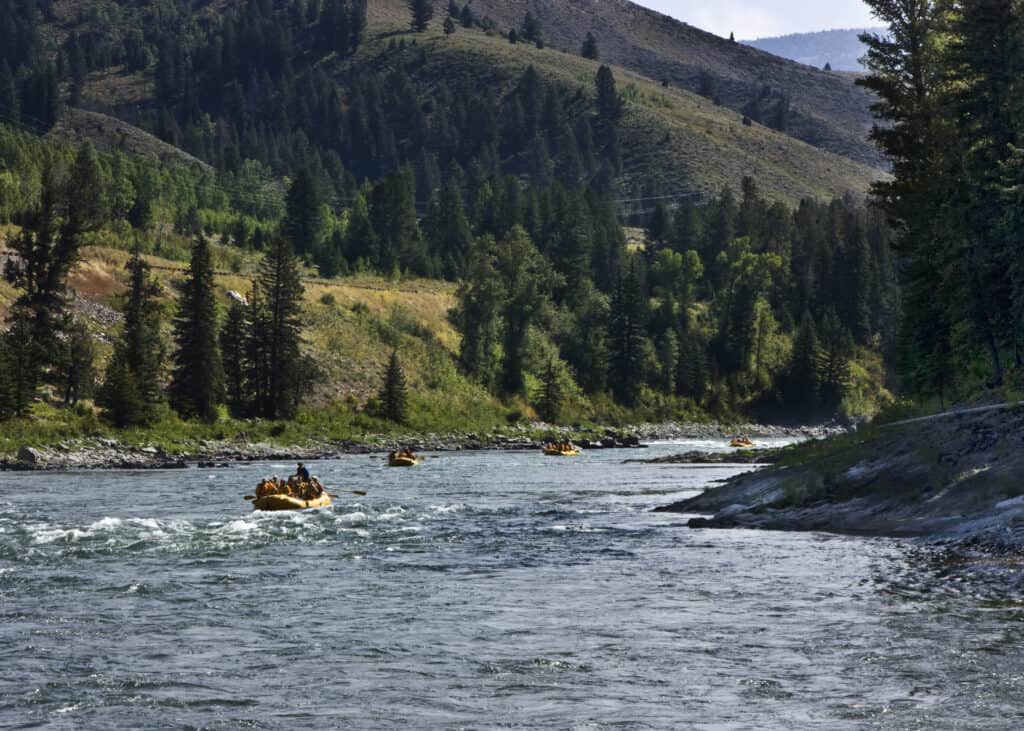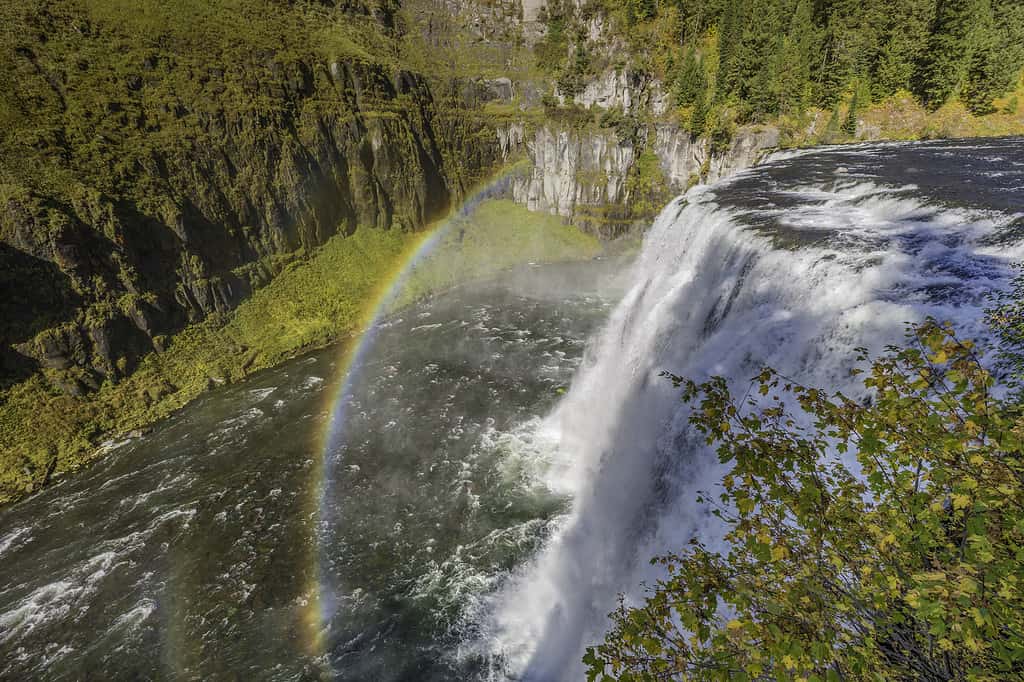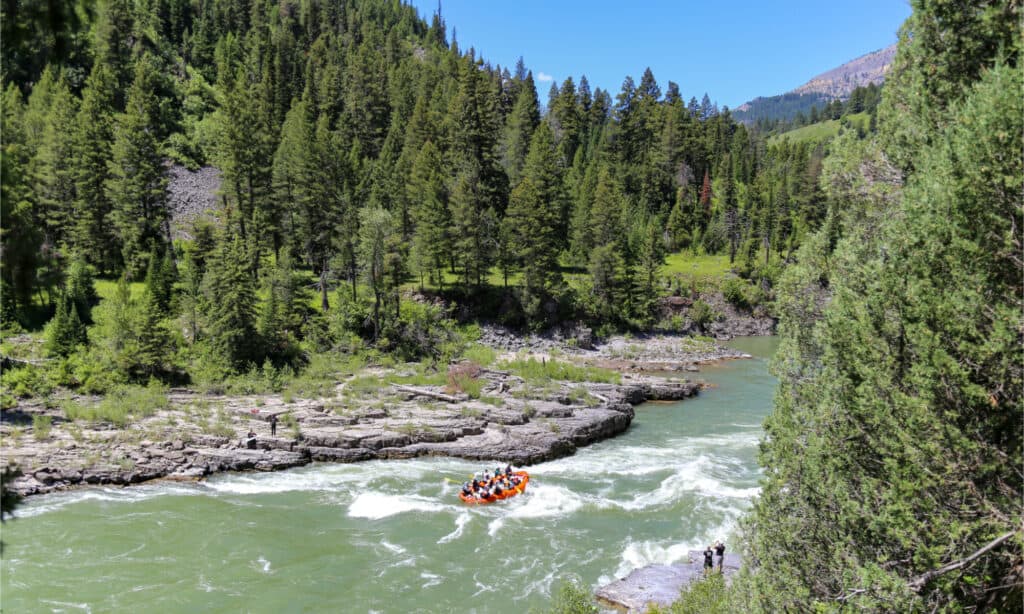The 1,078-mile-long Snake River is an invaluable resource to the six Pacific Northwest states that depend on it for hydroelectric power and agricultural irrigation. Considering the importance of the Snake River to the area, it’s interesting that the source of the river was a subject of debate for some time.
Early explorers traced the Snake River’s headwaters to Grand Teton and Yellowstone National Parks but had trouble defining the longest branch of streams as the official start of the river. Today we have the benefit of satellite imaging to settle the debate with complete certainty. Join us as we travel through some of America’s most breathtaking scenery to discover where the Snake River starts.
Where Does the Snake River Start?

The 1,078-mile-long Snake River commences its epic four-state journey within the picturesque Yellowstone National Park, along the Continental Divide.
©Tucker James/Shutterstock.com
The Snake River starts just inside Yellowstone National Park on the Two Ocean Plateau. According to the U.S. National Park Service (NPS), the head of the Snake is about three miles north of Phelps Pass, at a point on the Continental Divide inside Yellowstone.
“In 1926, John G. White showed a photo in his hand-typed book Souvenir of Wyoming of the ‘true source of the Snake,’ writing that ‘it is near the Continental Divide upon two ocean plateau,'” NPS reports. “‘A number of springs gush forth upon the hillside. Uniting, they form a small stream, which, at an altitude of two miles above sea level, begins its arduous journey…to the Pacific.'”
Where Does the Snake River Go?

Upper Mesa Falls is a waterfall on the Henrys Fork River, a tributary of the Snake River.
©Gerald Corsi/iStock via Getty Images
The Snake River flows through Wyoming, Idaho, Oregon, and Washington. The Snake River drainage basin, however, stretches into six states and encompasses 92,960 square miles. Between its headwaters in Wyoming and where it meets the Columbia in Washington, the Snake River and its tributaries tumble over breathtaking waterfalls, cut through spectacular canyons, and irrigate millions of acres of agricultural land along the way.
Wyoming
From its headwaters on Two Ocean Plateau in Yellowstone, the confluence of tiny mountain streams fed by springs amasses into the mighty Snake River. The river’s first stop is Jackson Lake in Wyoming. After meandering through Jackson Hole between the Teton Range and the Continental Divide, it leaves the Upper Snake River Canyon.
Idaho
Before making its way into Idaho, the Snake receives the Hoback and Greys Rivers. Its next stop is Palisades Reservoir in Idaho where the Salt River meets the Snake River. Once past the reservoir, the South Fork of the river flows over the Snake River Plain. The plain sits above one of the most productive aquifers in the United States, the Snake River Aquifer.
It becomes the Main Stem of the Snake River after receiving the North (Henrys) Fork River south of Rexburg. The Main Stem then changes course to start its journey west toward Oregon. After making a stop at American Falls Reservoir, the Snake drops over Shoshone Falls.
Washington
Continuing southward, it makes a stop at American Falls Reservoir. After plunging over Shoshone and Twin Falls, the Snake River heads northward to pass within 30 miles of Boise, ID. From Boise, it rides the Oregon/Idaho border 300 miles until it hits Clarkston, WA, where it veers westward into eastern Washington. The river flows for 150 miles through Washington before joining the Columbia River.
Why Is the Snake River Important?

The Snake River winds through Jackson Hole, WY, as well as through Idaho, Oregon, and Washington. It provides those states with billions of dollars through water-related activities like fishing and white-water rafting.
©CSNafzger/Shutterstock.com
Winding its way through four Pacific Northwest states, the Snake River is the fourth longest river in the country. It is the largest tributary of the great Columbia River, contributing to the Columbia’s status as draining more water into the Pacific Ocean than any other river in North or South America.
The Snake River is one of the country’s greatest hydrologic resources. There are 22 hydropower dams on the mainstem Snake River. These dams produce more than 1,100 megawatts of electricity. The Snake River is also called the lifeline of southern Idaho’s multi-billion-dollar agriculture industry. Water withdrawals from the Snake irrigate 3.8 million acres.
The photo featured at the top of this post is © Ansel B/Shutterstock.com
Thank you for reading! Have some feedback for us? Contact the AZ Animals editorial team.







